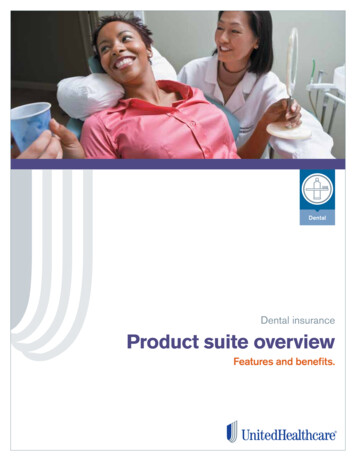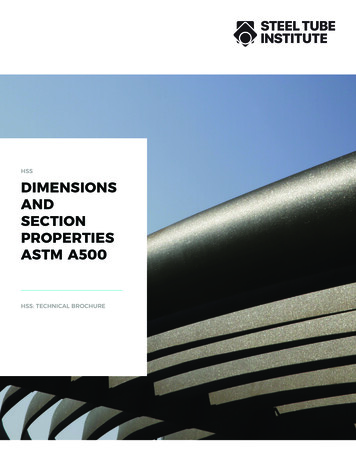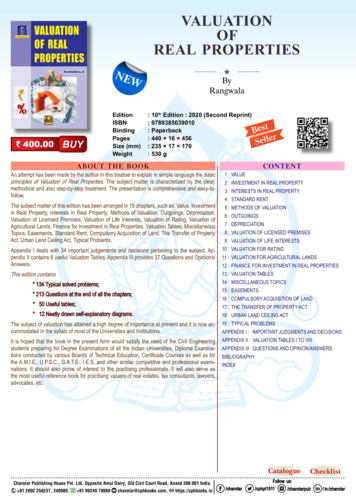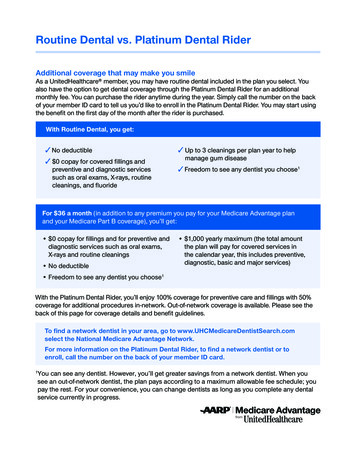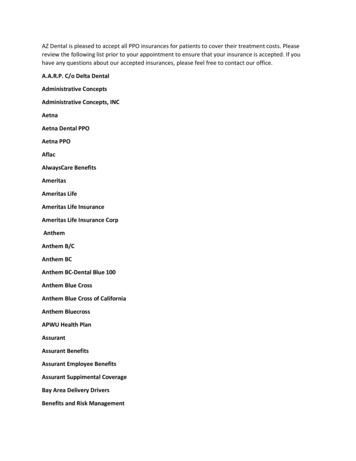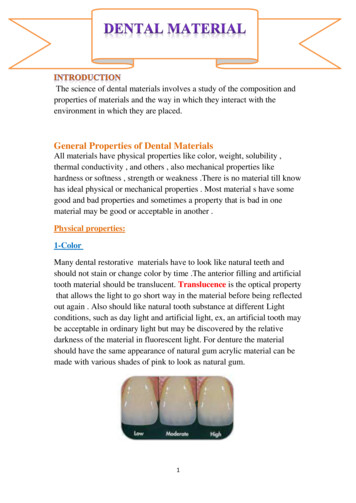
Transcription
The science of dental materials involves a study of the composition andproperties of materials and the way in which they interact with theenvironment in which they are placed.General Properties of Dental MaterialsAll materials have physical properties like color, weight, solubility ,thermal conductivity , and others , also mechanical properties likehardness or softness , strength or weakness .There is no material till knowhas ideal physical or mechanical properties . Most material s have somegood and bad properties and sometimes a property that is bad in onematerial may be good or acceptable in another .Physical properties:1-ColorMany dental restorative materials have to look like natural teeth andshould not stain or change color by time .The anterior filling and artificialtooth material should be translucent. Translucence is the optical propertythat allows the light to go short way in the material before being reflectedout again . Also should like natural tooth substance at different Lightconditions, such as day light and artificial light, ex, an artificial tooth maybe acceptable in ordinary light but may be discovered by the relativedarkness of the material in fluorescent light. For denture the materialshould have the same appearance of natural gum acrylic material can bemade with various shades of pink to look as natural gum.1
2- LINER COEFFICIENT OF THERMAL EXPANSION AND CONTRACTIONAs the temperature rises, a solid material will expand and on cooling itwill contract, this is measured by the liner coefficient of thermalexpansion and contraction which is the change in length per unit length ofa material for a 1 C change in temperature.a final length 𝑜𝑟𝑖𝑔𝑖𝑛𝑎𝑙 𝑙𝑒𝑛𝑔𝑡ℎ (𝑐𝑚)original length 𝑡𝑒𝑚𝑝.𝑐ℎ𝑎𝑛𝑔𝑒 (𝑐𝑚. 𝐶Hard tooth structure has the smallest coefficient, metals are intermediate ,polymers have the largest.Tooth 11*10-6 cm/cm. 𝐶Gold 14 *10-6 cm/cm. 𝐶Impression compound 250*10-6 cm/cm. 𝐶Filling material should have the same coefficient as the tooth, if it doesnot, it will press too hard against the cavity wall on expansion and maycause pressure on the pulp or pull away from the wall when chilled bycold water. The later effect may cause the filling to leak temporarily,which may in turn may lead to further carries.3-DIMENTIONAL STABILITY:Many materials change shape when they set or harden. Impressionmaterials should not change dimensions when set. Also dental materialsshould have no dimensional changes when set.Amalgam is a filling material for posterior teeth, it may sometimeschange shape permanently as a result of a heavy biting force. This is badproperty , on the other hand , the investment materials that forms the goldfor dental casting should expand for a certain amount to compensate forthe contraction of the molten metal after it is cooled from the moltenstage.4-DENSITYLightness is nearly always an advantage in restorative materials, butsometimes tin or lead is used inside full lower denture to make it heavy inorder to control its mobility.Density of gold 14gm/cmAcrylic 1.2 gm/cmCromium /cobalt 8.3gm/cmWater 1gm/cm2
5- SOLUBILITYRestorative materials should not dissolve in the mouth , and if it isdissolves, it should not release toxic substance.Solubility of silicate 0.7 -1.6%Solubility of composite 0.01 %6-ABSORPTION OF FLOUIDS:Some materials will absorb water or other fluids. If it is too much orcontinued for long time, this will result in serious d dimensional changesand the material will also be un hygienic. On the other hand, somematerials like acrylic will absorb water for a day and stop after that, so itis acceptable7-TISSUE REACTIONSome restorative materials are damaging to the living tissues which are incontact with, like silicate filling and zinc phosphate cement which is acidand may kill the dental pulp unless a protective lining is used. Dentalmaterials should not show any allergic reaction to the tissues and alsoshould not provide good culture for the growth of bacteria and candidainfection, like soft lining materials.8-THERMAL CONDUCTIVITYGenerally metals are better heat conductors than non-metals. Metal fillingmaterials like amalgam sometimes cause pulp pain by transmitting heat orcold more than natural tooth especially in deep cavities, thus they requireheat insulating layer between the filling and the pulp. Here is undesirableproperty on the other hand the thermal conductivity of metallic denturebase is an advantage as it gives feeling closer to normal condition and thepatient will feel normal also it will protect him from drinking very hotdrinks which may burn his mouth.3
9-ELECTRICAL ACTIVITYIt is the ability of metal to ionize by losing electrons. If there is a highdifference in the electrode potentials of metals in contact with the samesolution like gold and aluminum an electric cell may develop and thepatient may fell discomfort.The presence of metallic restorations in the mouth may cause aphenomenon called galvanic action, or galvanism. This results from adifference in potential between dissimilar fillings in opposing or adjacentteeth. These fillings, in conjunction with saliva or bone fluids such aselectrolytes, make up an electric cell. This cell short-circuited, and if theflow of current occurs through the pulp, the patient experiences pain andthe more anodic restoration may corrode, like gold with amalgam.10- ADHESION AND COHESIONAdhesion is the force which causes two different substances to attachwhen they are brought in contact with one another. When the moleculesof the same substance hold together; the forces are said to be cohesion.4
MECHANICAL PROPERTIESOne of the most important properties of dental materials of dentalmaterials is the ability to withstand the various mechanical forces placedon them during use as restoration, impression , models, appliances andtools.STRESSIs the force per unit area induced in a body in response tosome externally applied force. It is force\area measured in kg\cm2 orpound\inch2 or Pascal.STRENGTHIs the measurement of the resistance of the materialexternallyapplied force. There are many types of stresses according toHthe direction of the applied force, each type of stress is accompanied bythe same type of strain.STRAINeStrain Is the change in dimension per unit dimension caused byexternally applied force.final length original lengthoriginal lengthPercentage of elongation strain 100%1-Tensile stressIt is the force per unit area induced in the body in response to externallyapplied force which tends to elongate or stretch the body, it isaccompanied by tensile strain.5
2-Compressive strainIt is the force per unit area induced in the body in response to externallyapplied force which tends to compress or shorten the body, it isaccompanied by compressive strain. Investment materials, restorativematerials and models should have high compressive strength.3-SHEAR STRESSIt is the force per unit area induced in the body in response to externallyapplied force which is applied to one part of the body in one directionand the rest is being pushed in the opposite direction.It is the strength of the middle of abeam, which is supported only at itsend. It is important in dental bridges.It is when the material is constantly subjected to change in shape due tofrequent application of force like clasp arm of partial dentureIt is the ability of the material to break on sudden impact. Low impactstrength mean brittle material, like dropping of the denture.STRESS STRAIN CURVEProportional limitWhen a stress is applied to a material, the material will tend to deform(change in shape and dimension) in an amount proportional to themagnitude of applied stress. The greatest stress which may be producedin the material such that the stress is directly proportional to the strain.Elastic deformation (elastic limit)The greatest stress to which the material can be subjected such that it willreturn to its original shape and dimension when the stress is removed.If the strength is increased beyond the elastic limit or the proportionallimit the material will deform and if we remove the stress the materialwill not return to its dimension. This is called plastic deformation. If thestress is increased more and more the material will break.Ultimate strengthIs the greatest stress which break the material.MODULUS OF ELASTISITYIs the constant of proportionality. It is when any stress value equal or lessthan the proportional limit is devided by corresponding strain value.Modulus of elasticity 𝑥 stressstrainkg \cm2 or PSI or pascal6
DUCTILITYIt is the ability of the material to withstand permanent deformation undertensile stress without fracture ; it depends on plasticity and tensilestrength. It is the ability of the material to be drawn into a fine wire.MALLIABILITYIt is the ability of the material to withstand permanent deformation undercompressive stress without fracture. It is the ability of the material to bedrawn into a sheet.TOUGHNESSIt is the total work or energy required to break the material. It is the totalarea under the stress – strain curve. It requires strength and plasticity.BRITTLENESSIt is the opposite of ductility, it requires lack of plasticity.FLEXIBILITYThe higher the strain which accrues when the material is stressed to itsproportional limit.RESILIANCEThe amount of energy absorbed by a structure when it is stressed withinthe proportional limit.HARDNESSIt is the resistance of the material to deformation caused by penetrating orstarching the surface.7
It is important in dental bridges. It is when the material is constantly subjected to change in shape due to frequent application of force like clasp arm of partial denture It is the ability of the material to break on sudden impact. Low impact strength m


